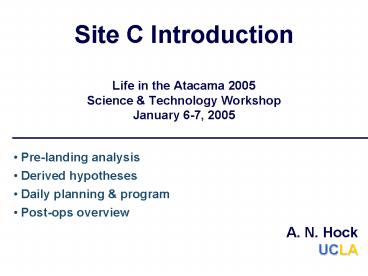Site C Introduction Life in the Atacama 2005 Science - PowerPoint PPT Presentation
1 / 10
Title:
Site C Introduction Life in the Atacama 2005 Science
Description:
Science & Technology Workshop. January 6-7, 2005. Pre-landing analysis. Derived hypotheses ... Life in the Atacama 2005 Science/Technology Workshop. 1 ... – PowerPoint PPT presentation
Number of Views:36
Avg rating:3.0/5.0
Title: Site C Introduction Life in the Atacama 2005 Science
1
Site C IntroductionLife in the Atacama
2005Science Technology WorkshopJanuary 6-7,
2005
- Pre-landing analysis
- Derived hypotheses
- Daily planning program
- Post-ops overview
- A. N. HockUCLA
2
Site C
- Goals
- Find life!
- Science demonstration identify prime site for
future analysis/return - Technology demonstration return to prime site
and/or landing site - Scanning traversefrequent standard
observations along traverse with selected focused
investigation - Strategy
- Pre-landing analysis?i.d. potential
habitats?long-term planning?daily planning - Regional geologic/biologic survey tuned to
spatially-scaled hypotheses (orbital-local-micro
scale observations) - Traverse summary
- 7 sols
- 10 unique locales
- 8 km planned traverse
3
Pre-landing analysis
- Topic
- Outline
- 2004 Results
- 2005 Issues
4
Derived hypotheses
- Small topographic basins (due to ponding, etc.)
represent enhanced biological potential. These
areas also appear as high albedo in ASTER 321
image, suggesting potential presence of evaporite
lithology. - Quartz mineralogic signatures identified using
thermal emission spectra indicates increased
potential for hypolithic (photosynthetic
colonization under rock) habitats. - Geologic materials exposed at the surface with
both high reflectance in the near infrared and
relatively low reflectance in the visible
wavelength spectra using VNIR suggests the
presence of evaporite minerals (e.g. gypsum). - Note solar insolation (a function of location
time of year, local atmospheric conditions and
micro- to macro-topography) provides a strong
control on habitability. Certain locations may
benefit from increased insolation while others
may benefit from shade (e.g. many non-polar
desert ecosystems). - Note elevation generally increases eastward
along the major axis of the landing ellipse
under certain circumstances, higher altitude
terrain may preferentially trap atmospheric water
vapor, as well as south-facing slopes.
5
Daily planning program
- 1300 Start. Individual work time.
- 1500 Meeting.
- 1) Review previous days data in light of
previous days hypotheses. - 2) Outline plan for tomorrow beyond ending locale
using available data. - 1700 Multitask.
- Operations Upload outline plan actions to
Eventscope text document. - Analysis Continue data review.
- Coffee/snack.
- 1800 Initiate downlink daily summaries.
- 2000 Downlink complete individual review of
incoming data. - 2100 Processing complete rover team engineering
report. - 2130 Data overview silent.
- 2200 Planning further ops at previous locales?
- No implement outline plan.
- Yes incorporate requested actions in to outline
plan. - 2200-2300 Triangulate current location and
planned locales. Optional coffee/snack. - 2250 Notificationclock for action changes
running out (Kiva Han closes in ten). - 2300 Finalize planned traverse in Eventscope,
text support doc changes to plan.
6
Site C post-ops overview
- Sol 8 (locale 25) site C landinghigh
resolution pan long-term planning - Sol 9 (26) evaporites? Heading SW to
topographic low and possible change in mineralogy - Sol 10 (29, 30) tourismtraverse over several
geomorphic units gaining vantage on hilly unit. - Sol 11 (34) heading to light-toned units in S.
- Sol 12 (36, 38) contd
- Sol 13 (39-41) going on a 5k runSouth to large
drainage - Sol 14 (25) heading homeone stop at
previously-identified site of interest
7
Site C post-ops overview
8
Site C critical analysis - science
- ! We CAN i.d. a site of interest and return to
it, as well as the landing site - Accurate return (meter-scale) required for
microclimate and habitat - 2 sols operations currently required for this
- Standard action request for scanning traverse
- Low-resolution greyscale SPI panorama
- Cross-patterned VNIR and compass VNIR
- Single FI frame with dyes
9
Rationale Traverse to the light albedo material
located to the north.
Site C critical analysis - science
- Templates needed for data analysis and
presentation, not just planning - e.g., Fishers FI and Marinangeli, Dohms Geo
presentation difficult analysis presentation
of weather data
Satellite Visible are patches of light materials
and dark material and scarps. Field-based
Background Sky appears mostly sunny, though hazy
(similar to yesterday). Other promontories,
which were visible yesterday on the horizon, are
no longer visible. Foreground Abundance of
distinct rocks (relatively large 15cm or
greater) is considerably less than Locale 26. In
addition, polygonal patterns are visible. When
compared to the landing site, few if any larger
dark rocks and white clasts are visible. In
addition, polygonal patterned ground is thus far
unique. Microscopic Diversity in lithology
based on color, shape (angular to rounded some
elongated), and size (generally centimeter or
less). Greater percentage of white surface when
compared to the non-plowed surfaces of the
previous 2 localities.
1 cm
10
Site C critical analysis - logistics
- IT better telecon, printing capabilities
- Planning huge improvements in Eventscope
- Automated generation of text support documents
- Implemented frequently-requested actions, ability
to recall actions from previous locales - Common language is mission-critical
- Action. Task performed by a rover payload
element. - Locale. Anywhere the rover stops and deploys a
payload element. - Outline plan. Plan developed independent of
prior days data. - Plan. A set of locales and associated actions,
waypoints. - Support document. Text version of plan for field
team. - Target. An object/area chosen for investigation
defined by spatial coordinates of action. - Waypoint. A rover stop with no associated
actions.































